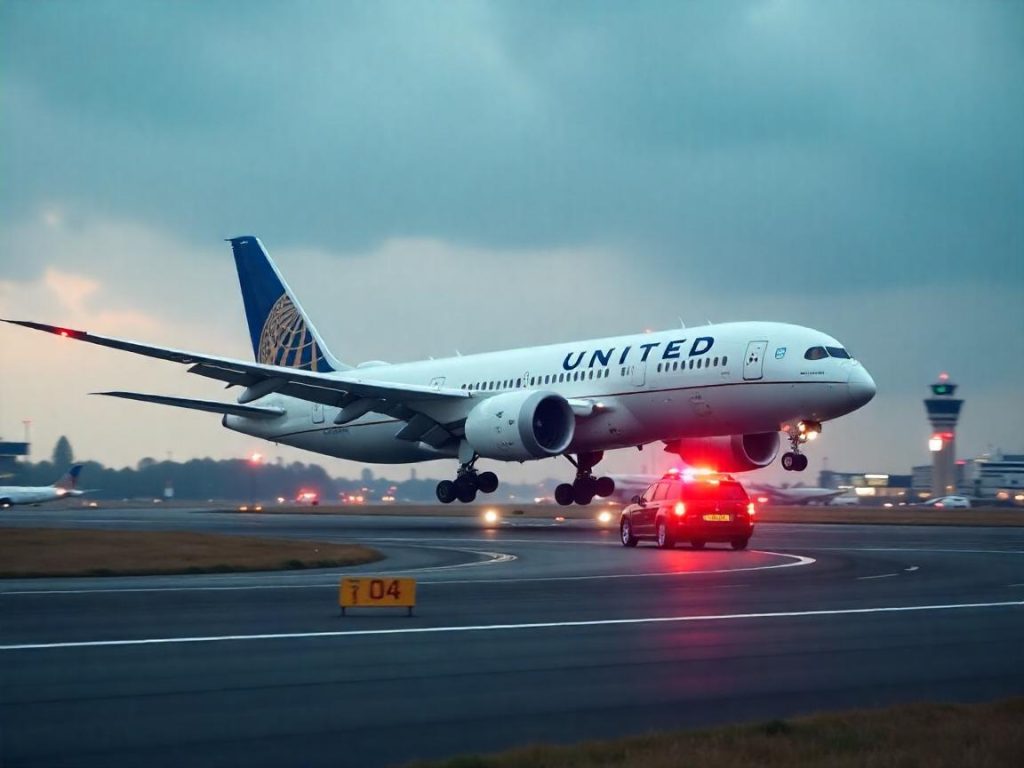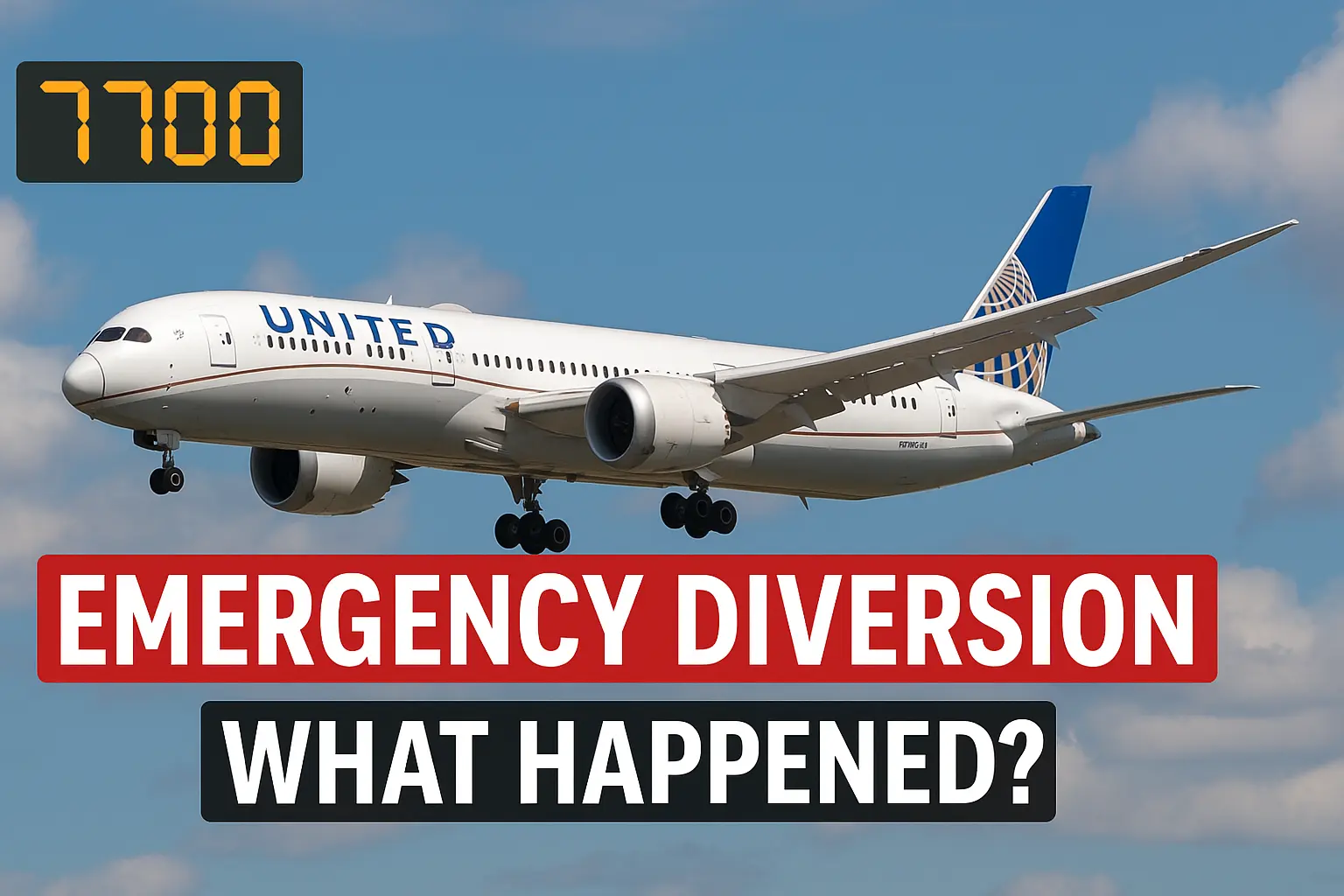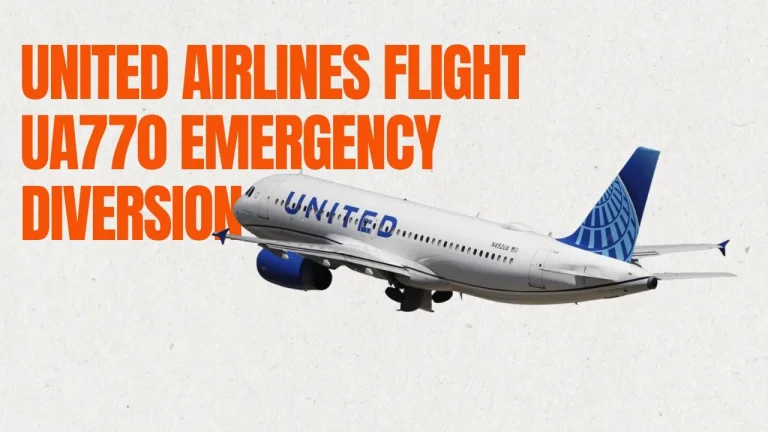What began as a routine journey quickly became a moment of high-stakes decision-making aboard United Airlines Flight UA770. The aircraft, cruising smoothly at altitude, was suddenly diverted due to an unexpected in-flight emergency—a reminder that even in the most controlled environments, challenges can arise without warning.
Thanks to the swift response of the flight crew and adherence to United Airlines’ emergency protocols, the situation was handled with professionalism, care, and efficiency. This mid-air diversion, though unplanned, demonstrated just how well-prepared modern airlines are to protect the safety and well-being of their passengers.
Flight Overview: What is United Airlines Flight UA770?
Flight UA770 is a long-haul route regularly operated by United Airlines using a Boeing 787‑8 Dreamliner, flying daily from Barcelona–El Prat Airport (BCN) to Chicago O’Hare International Airport (ORD). The flight typically departs mid-afternoon (around 15:15 CEST) and covers approximately 4,430 miles (7,130 km) in about 9 hours and 45 minutes .
The aircraft features a three-class cabin layout—Business, Premium Economy, and Economy—with a total of 243 seats As part of United’s international fleet, UA770 often includes codeshares (e.g., Lufthansa LH8858) and maintains frequent scheduled departures each weekday
Beyond this specific route, UA770 is also a flight number used on other legs (such as Newark to Los Angeles or domestic flights like Houston to New Orleans), but in the context of the emergency diversion, we’re referring to the BCN ➝ ORD routing on the 787 Dreamliner
Key Details:
| Attribute | Description |
|---|---|
| Aircraft Type | Boeing 787‑8 Dreamliner |
| Route | Barcelona (BCN) → Chicago (ORD) |
| Flight Time | Approximately 9 hours 45 minutes |
| Seating | 243 seats (Business, Premium Economy, Economy) |
| Schedule | Daily on weekdays, mid-afternoon departure |
The Incident: What Caused the Emergency Diversion?
On what was expected to be a smooth and uneventful transatlantic flight, United Airlines Flight UA770 encountered an unexpected challenge mid-air. Approximately halfway through its journey from Barcelona (BCN) to Chicago (ORD), a medical emergency involving a passenger prompted the flight crew to take immediate action.
While the exact medical details were not disclosed due to privacy concerns, eyewitnesses and aviation tracking data confirm that the aircraft initiated a controlled descent and diverted course to the nearest suitable airport capable of handling both international traffic and medical emergencies.
In-Flight Medical Emergencies: A Quick Breakdown
Medical emergencies at 30,000 feet are not uncommon. From sudden cardiac events and breathing difficulties to allergic reactions or fainting spells, airlines must be prepared for anything. On UA770, the situation was deemed severe enough to warrant urgent landing assistance, suggesting either a life-threatening condition or a passenger in need of hospital-grade care.
Once the issue was identified:
- The flight crew followed standard emergency protocols.
- The pilot declared a medical emergency to air traffic control.
- The aircraft rerouted toward the nearest capable airport, ensuring access to immediate medical support upon landing.
Crew Response: Inside United Airlines’ Emergency Protocols
When every second counts, the difference between chaos and calm often lies in the training and preparedness of the flight crew. On United Airlines Flight UA770, the response to the mid-air medical emergency was swift, professional, and by the book—reflecting the high standards of United Airlines’ emergency procedures.
Trained for the Unexpected
Flight attendants and pilots are far more than just service personnel and navigators. They undergo rigorous emergency training, which includes:
Handling medical crises like cardiac arrest, seizures, and respiratory distress
- Administering first aid and CPR
- Using emergency medical kits and Automated External Defibrillators (AEDs)
- Communicating clearly and calmly during emergencies
- Coordinating with medical professionals on the ground via radio
On UA770, once the emergency was identified, the cabin crew immediately responded, performing an initial assessment and determining the need for urgent medical care.
Communication with the Cockpit
The flight attendants quickly informed the cockpit of the situation. The pilot in command, following United’s protocol, notified air traffic control (ATC) and United’s operational center. Together, they coordinated the most viable alternate landing location, balancing passenger safety with urgency.
United Airlines also works with MedAire, an emergency medical advisory service that connects crews in real-time with doctors who guide inflight medical responses. This kind of support was likely a factor in the decision to divert the flight.
Passenger Experience: Voices from the Cabin
While flight crews are trained to handle emergencies, the passenger experience during an inflight diversion can vary greatly depending on communication, atmosphere, and how swiftly the situation is handled. On United Airlines Flight UA770, passengers reported a mix of initial confusion, growing concern, and eventual relief as the flight made its emergency landing.
Calm Amid the Crisis
According to statements shared on social media and aviation forums, most passengers were unaware of the medical emergency until the pilot made an announcement informing them of the diversion. The tone of the crew remained calm and professional throughout, helping to ease tension in the cabin.
“We knew something was going on when the plane started to descend earlier than expected. But the crew was reassuring, and there was no panic,” said one passenger via X (formerly Twitter).
“The announcement was clear, and they kept us updated the whole time. It wasn’t scary—just unexpected,” noted another traveler.
Outcome: What Happened After Landing?
Once United Airlines Flight UA770 successfully diverted and landed at the designated airport, the crew’s swift and organized actions continued on the ground. Emergency medical personnel were already on standby, thanks to prior coordination between the cockpit and ground control during the descent.
The passenger in distress was immediately attended to by paramedics and safely transported to a nearby medical facility for further evaluation and treatment. No other passengers were reported injured, and the crew ensured that all safety procedures were followed during deplaning and medical intervention.
For the remaining passengers, the unexpected landing prompted logistical changes. United Airlines staff worked quickly to:
- Provide real-time updates via mobile alerts and gate agents
- Offer rebooking assistance for missed connections
- Distribute meal vouchers and accommodation, if necessary
Many passengers were allowed to remain on the same aircraft once it was cleared to continue its journey. In some cases, depending on the length of the delay and local regulations, passengers were deplaned temporarily and asked to reboard after refueling and a security check.
Despite the diversion, most travelers expressed understanding and appreciation for how the situation was handled. United Airlines also released a brief statement affirming that the decision to divert was made out of an abundance of caution, prioritizing the safety of all onboard.
Airline Safety First: Lessons from the UA770 Emergency
The emergency diversion of United Airlines Flight UA770 is more than just a headline—it’s a powerful reminder of how essential airline safety protocols are in real-life situations. From the moment a medical emergency was identified, every action taken by the flight crew reflected United Airlines’ commitment to protecting lives, maintaining order, and following well-established emergency response procedures.
Key Safety Lessons from the UA770 Diversion
| Lesson | Description |
|---|---|
| Preparedness Saves Lives | The crew’s immediate, trained response ensured a quick and safe reaction to the in-flight medical emergency. |
| In-Flight Communication Matters | Clear and calm updates from the flight deck and cabin crew helped passengers remain composed. |
| Medical Tools Are Critical | Use of onboard medical kits and AEDs helped stabilize the passenger before landing. |
| Ground Coordination is Essential | Effective communication with air traffic control and medical responders ensured a smooth and safe emergency landing. |
| Passenger Understanding is Growing | Passengers showed empathy and patience, reinforcing the importance of public awareness about airline safety protocols. |
Media Coverage & Public Reaction
The emergency diversion of United Airlines Flight UA770 didn’t go unnoticed. Within hours of landing, the incident gained traction across social media platforms and aviation news outlets. While it wasn’t a disaster, it served as a reminder of how quickly a standard flight can turn into a high-alert situation—and how important a professional airline response is in such moments.

News Headlines: Focus on Safety and Response
Several aviation and mainstream news sites reported on the incident, emphasizing:
- The crew’s swift decision-making
- The medical nature of the diversion
- The safe landing and prompt medical attention
Headlines like “Medical Emergency Forces UA770 Diversion—United Crew Praised” and “United Airlines Handles In-Flight Crisis with Precision” helped frame the event as a well-managed, non-panic emergency handled by experienced professionals.
United Airlines issued a brief official statement, confirming the diversion was due to a medical emergency and that the safety of their passengers and crew remains their top priority.
Reactions on Social Media
Passengers on board and aviation enthusiasts took to Twitter (X), Reddit, and Facebook to share their experiences. The overall tone of public reaction was overwhelmingly positive:
“Kudos to the @united crew on #UA770. Calm, collected, professional. Glad to see safety comes first.”
“Flight diverted for medical reasons. Crew handled it perfectly. Hope the passenger is okay. #UA770”
Social media threads praised the professionalism of the staff, the calm tone set in the cabin, and the rapid medical response awaiting the flight on the ground.
Public Trust in Air Travel
Incidents like UA770’s diversion actually strengthen trust in air travel, proving that even unexpected crises are handled with training, teamwork, and transparency. Public reaction reflects growing awareness of aviation safety and appreciation for the people behind the scenes who keep the skies secure.

Tracking and Data Sources html tabel code
| Source | Purpose | Link |
|---|---|---|
| FlightAware | Real-time flight tracking, flight history, diversion data | Visit FlightAware |
| FlightRadar24 | Live flight path, aircraft info, diversion alerts | Visit FlightRadar24 |
| United Airlines Flight Status | Official updates from United on delays, diversions, or cancellations | Check Flight Status |
| Aviation Herald | Incident reports, expert aviation news, and safety analysis | Visit Aviation Herald |
| AirLive | Breaking aviation news, including diversions and emergencies | Visit AirLive |
Final Thoughts
United Airlines Flight UA770’s emergency diversion is not just about an unexpected detour—it’s a powerful reminder of the strength, skill, and coordination required to keep passengers safe at 35,000 feet. From the moment a medical emergency was detected, the flight crew’s swift and professional response ensured that one life could be cared for, while hundreds of others remained calm and protected.
This incident also shines a light on the importance of airline training programs, in-flight medical readiness, and ground support collaboration. Passengers walked away not just with a delayed arrival, but with a deeper appreciation for the human side of aviation—the dedication, compassion, and readiness that crews bring to every flight.
In a world where air travel is often taken for granted, Flight UA770’s story reinforces trust in aviation safety. Emergencies may be rare, but the people entrusted with our journeys are more than ready to rise to the occasion when they occur.
